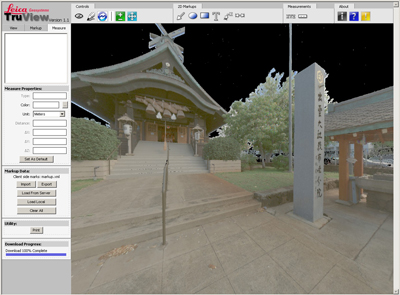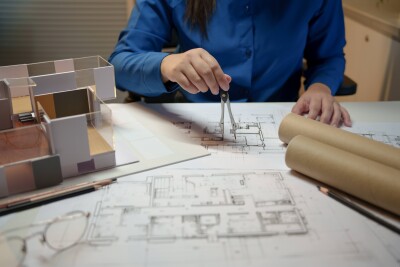Dr. Dennis Hirota, president of Honolulu survey firm Sam O. Hirota Inc., is combining 3D laser scanning and spherical color photography to document religious buildings in the Hawaii community. “I decided to do some scans for the churches that our family has been connected with,” he told us. “We currently have a Spheron spherical camera. We have an adapter that puts the focal point of both the Z+F IMAGER 5006 scanner and the Spheron at the same point, so all we need are a few points to register the color spherical image and the 5006 scan using Z+F’s Laser Control software to come up with a color RGB scan.”
“Right now we’re focused on the historic preservation marketplace,” continues Hirota, whose family came to Hawaii from Japan three generations ago. “I’ve contacted the churches our family has been closely associated with, and told them I would help them document these historic buildings.” First was the Izumo Taisha temple, a Shinto temple in Honolulu built in 1923. “It came under pressure during World War II because the military thought the Japanese churches in Hawaii were harboring spies,” he says, “and my grandfather – my mother’s father – was instrumental in keeping this Shinto temple there.”
“What happened,” he explains, “was that this past Memorial Day, my family was visiting my grandparents’ grave, and we found two men there placing flowers on my grandfather’s grave. They weren’t part of our family, so I asked who they were. They turned out to be the two grandsons of the Shinto priest who first came here to start this temple. For 35 years I had never known who had been putting flowers on my grandfather’s grave.” Why the connection? “These two people were so grateful that my grandfather helped their grandfather.” After that discovery, “I was so grateful that I explained to them I had this equipment, and would be glad to help them document this historic place.”
Continued
Makiki Christian Church
“The second historic building I did,” Hirota says, was the Makiki church of Honolulu, built in 1934. The story here “started with a Christian minister named Reverend Takie Okumura who established a dormitory at the University of Hawaii. That was a boon to people like my dad who lived too far from the university to attend from home. This dormitory made it possible for my dad to go to engineering school – he was one of the few in his community who could. My mom, who’s 95, still attends that church. So I called a friend who’s a member, and told him I would like to document this historic building.”
Continued
Hawaii State Capitol
The state capitol building in Honolulu was a project Hirota chose to do “when we first got the Spheron camera. The building is unique, and something everybody recognizes as being in Hawaii. So we went in and captured the interior of the courtyard. Like all our historic building projects, we did that for free, just in the interest of helping preserve these places.”
Click here to view animation of Hawaii State Capitol Spheron digital image file (2.4Mb Quicktime Movie). Courtesy Dr. Dennis Hirota, Sam O. Hirota, Inc., Honolulu
Work process
“Part of the interest in these projects,” Hirota observes, “is that I don’t think many people, besides maybe forensic specialists, are using the Z+F 5006 with a spherical camera.” What’s the key technically? With the Z+F/Spheron pairing, “to make the workflow very efficient, we have a pair of adapters, one built by Spheron and the other by Z+F, that cause the focal points of the two devices to be at the same point. That allows the workflow of combing the two data sets to go very well.”
Capture time for a typical IMAGER 5006 scan of 30 million points is three to four minutes. The Spheron VR HDR camera produces a calibrated color digital image in two to 15 minutes depending on light conditions. The system uses tribrach adapters to level the mount and ensure that the focal points of both sensors are identical. Post-processing starts with Z+F Laser-Control software used to merge the laser scans and spherical HDR color images. The merged RGB/point cloud files are imported and registered in Leica Cyclone software, then color 3D data is exported in TruView format for viewing with any web browser.
What’s next? “We’re now working with a Seitz spherical camera,” Hirota tells us. Why the Seitz? “It has a very high-speed data back that allows capture of 470 million pixels in 2.1 seconds, so I can capture a building interior in something like 5 seconds. We’re now in the process of getting an adapter for our Seitz Model D3 camera, and we need to help Seitz calibrate their camera so we can run it in the same mode as we do the Spheron.” He adds, “Of course we’re already using the Seitz in applications where this calibration with the scanner is not critical – for example, online advertising.”
Dennis Hirota is someone who is always pushing the edge of what’s possible, and what’s applicable – he scours the earth for 3D and imaging technologies to bring to his practice in Honolulu. He’s a treasure for the State of Hawaii, and for the industry.






